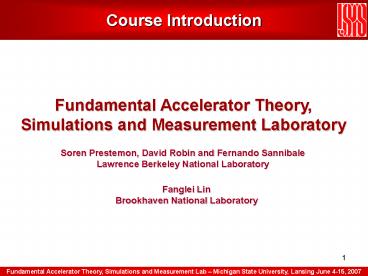Fundamental Accelerator Theory, - PowerPoint PPT Presentation
1 / 8
Title:
Fundamental Accelerator Theory,
Description:
Ilkyoung Shin, University of Connecticut, gs. Satomi Shiraishi, University of Chicago ... Simulations will give a taste of accelerator designing. 4 ... – PowerPoint PPT presentation
Number of Views:65
Avg rating:3.0/5.0
Title: Fundamental Accelerator Theory,
1
Fundamental Accelerator Theory, Simulations and
Measurement Laboratory
Soren Prestemon, David Robin and Fernando
Sannibale Lawrence Berkeley National Laboratory
Fanglei Lin Brookhaven National Laboratory
2
- Michael Aiken, Jefferson Lab, bs
- Anas Ali Almuqhim, King Abdulaziz City for
Science Technology (Saudi Arabia), bsp - Adel Abdullah Alzeanidi, King Abdulaziz City for
Science Technology (Saudi Arabia), bsp - Ramakrishna Bachimanchi, Jefferson Lab, bsee
- Anthony Beukers, SLAC
- Alexandre Bonatto, Universidade Federal Do Rio
Grande do Sul (Brazil), gs - Ryan Carey, Cornell University, bsee
- Saravan Kumar Chandrasekaran, Michigan State
University/NSCL, gs - Karen Fiuza, Universidade Federal do Rio Grande
do Sul (Brazil), gs - Brian G. Freeman, Jefferson Lab, bs
- Paul Gibson, Oak Ridge National Lab/SNS, mba
- Ranjan Grover, Brookheaven National Laboratory
- Matt Hodek, Michigan State University, gs
- Jeremiah Holzbauer, Michigan State University, gs
- Marianne Keck, Keystone High School and MSU, gs
- Nicholas Leioatts, Florida Institute of
Technology, ug - Heidi Lesser, Oak Ridge National Lab /SNS, bs
- Cary Long, Oak Ridge National Lab / SNS, mscs
- Rashi Nathawat, University of Rajasthan, Jaipur,
India
3
- General overview of the particle accelerator
field - addressed to a very diversified audience.
- Most of the issues will be discussed at the
level of general description with special accent
on the important concepts.
- Significant examples will be studied in more
detail.
- The lab part requires hands on participation and
will give a real feeling on common problems in
accelerator physics and engineering.
- Simulations will give a taste of accelerator
designing.
!!!
- All of this in two weeks
- At the end of the course, survivors should have
developed the vocabulary required for the
understanding of most of the important issues in
accelerators.
4
- 900 am - 1215 pm Two 1,5 hour lectures with
15 min. break in between.
- 1215 - 200 pm Lunch interval.
- 200 - 500 pm Three hours laboratory and
simulations.
- In the evening during the homework time,
instructors will be available for further
discussion on course related topics.
- Fanglei Lin 1st and 2nd week laboratory,
simulations and homework assistant
- Soren Prestemon 1st and 2nd week lectures,
laboratory and simulations
- David Robin 1st week lectures
- Fernando Sannibale 1st and 2nd week lectures
5
Monday Jun. 4 Tuesday Jun. 5 Wednesday Jun. 6 Thursday Jun. 7 Friday Jun. 8
900 am to 1030 am L4 Changing the particle energy. F. Sannibale
1045 am to 1215 am
L4 Changing the particle energy. F. Sannibale
L2 Maxwell equations and special relativity in
accelerators D. Robin
L6 Optical functions Betatron Motion D. Robin
L8 Lifetime in storage rings F. Sannibale
Presentation Introduction F.Sannibale
L1 Historical overview, accelerator examples
and applications D. Robin
L9 Collective effects. Single multibunch
instabilities F. Sannibale
L3 Single particle dynamics. Matrix
representation of the accelerator elements D.
Robin
L5 Phase space representation. Ensemble of
particles, emittance F. Sannibale
L7 Longitudinal Dynamics. D. Robin
Monday Jun. 11 Tuesday Jun. 12 Wednesday Jun. 13 Thursday Jun. 14 Friday Jun. 15
900 am to 1030 am
1045 am To 1215 am
L16 Other accelerator applications F.Sannibale
L12 Superconductivity for accelerators. S.
Prestemon
L14 Light sources and brightness. F. Sannibale
L10 Injection extraction F. Sannibale
Final Exam
L13 Real accelerators. errors and
diagnostics F. Sannibale
Course summary and discussion F. Lin, S.
Prestemon, F.Sannibale
L15 Colliders and luminosity F. Sannibale
L11 Particle sources F. Sannibale
Final Exam
6
- The main reference is Helmut Wiedemann,
Particle Accelerator Physics I, Springer Editor,
second edition (1998).
- The lectures does not have the same structure
and organization of the main reference text book,
but most of the arguments treated on the lectures
are present on the main reference as well.
- Lectures viewgraphs (handouts) have been
organized in the attempt of being
self-explanatory, requiring minimum consultation
of other references.
- Other references, when used, are specified at
the end of the lectures.
7
- Daily homework will be assigned and it is due
for the next day. - Collaboration between students is encouraged.
- Lab experiments will require a report for each
of the two weeks.
- In a three hour final test, recapitulation
problems will be assigned that must be resolved
individually.
- The final grade will be defined by combining
with equal weight the results obtained in the
three activities above.
Good luck!!!
8
University of Arizona, Phoenix January 2006































